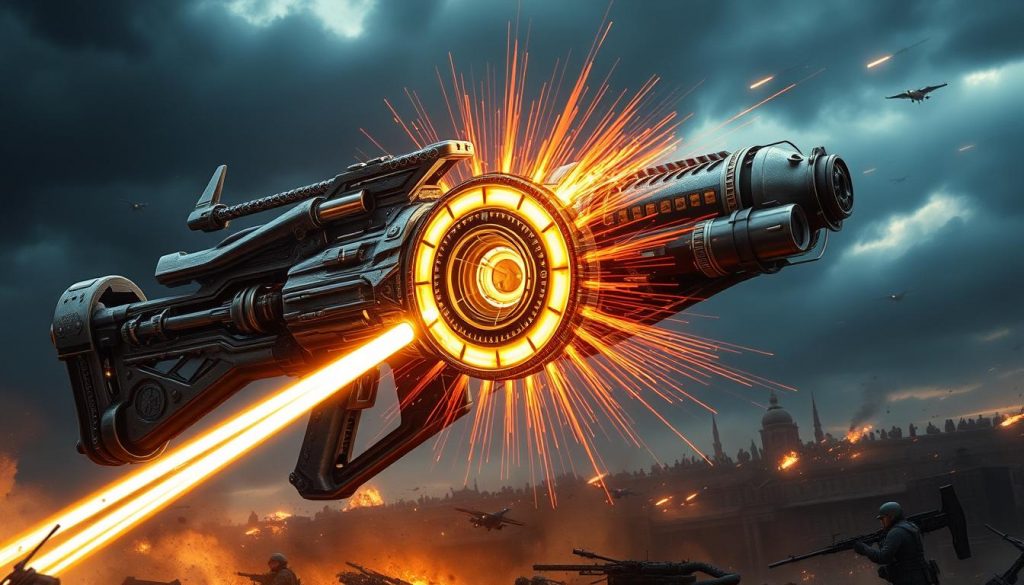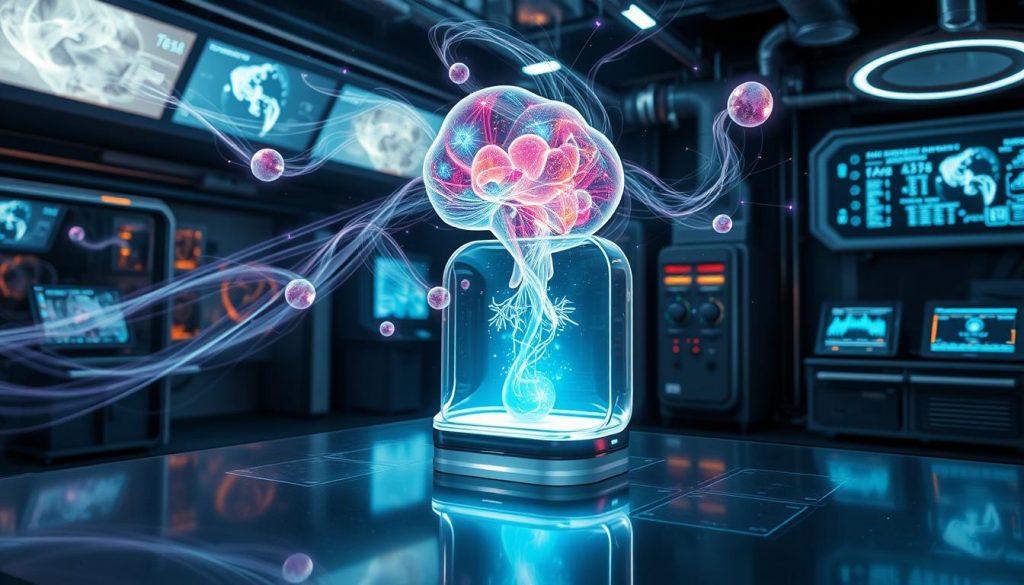Nikola Tesla’s lost projects and their potential applications.
Nikola Tesla was a visionary inventor who left a legacy of groundbreaking inventions. His work on alternating current and wireless power transmission has inspired many. Many of his projects are lost or unfinished, sparking mystery and intrigue.
Anúncios
After Tesla’s death, the U.S. government took his possessions, fearing his technology could harm national security. This has had a lasting impact on the development of new inventions. It has also sparked interest in exploring Tesla’s lost projects.
Tesla’s innovations are seen in today’s technologies, like wireless communication and remote control systems. This shows how important his work is. In this article, we’ll look at some of Tesla’s most fascinating lost projects. We’ll explore their potential to shape the future of technology.
The Mysterious World of Nikola Tesla’s Lost Projects
Nikola Tesla’s work is a mix of innovation and mystery. His lost projects have sparked a lot of curiosity and debate. His death and the U.S. government taking his documents have led to a mysterious world of speculation and controversy. As we explore Tesla’s files, we find clues that lead us on a journey of discovery.
Anúncios
The lost projects of Nikola Tesla show his endless creativity and innovative spirit. Projects like the “Death Ray” and the earthquake machine have amazed people worldwide. The mystery of missing documents has sparked debate, with many wondering what secrets Tesla’s files might hold.
- Wireless power transmission
- Advanced defensive weapons
- Earthquake machines
- Flying machines
These areas of research and development have big implications for our understanding of themysterious worldof Tesla’s lost projects. As we learn more about Tesla’s work, we might find new insights and discoveries. These could help us understand the genius of this pioneering inventor.
Nikola Tesla’s work continues to inspire and fascinate people around the world, with his lost projects remaining a source of intrigue and speculation. As we delve deeper into the secrets of his files, we may uncover new and exciting discoveries that can help us better understand the mysterious world of Nikola Tesla’s lost projects.
The Wireless Power Transmission System
Nikola Tesla’s work on wireless power transmission was truly groundbreaking. His experiments sparked both wonder and doubt. He filed a patent for his wireless power transmission system on September 2, 1897. It was granted on March 3, 1900.
The idea of wireless power transmission could change how we view energy and power. It could make energy systems more efficient and green. Nikola Tesla‘s work on this technology was a major step forward.
Nikola Tesla‘s dream for a wireless power transmission system was big. His efforts were vast, even though the project didn’t succeed. Yet, his ideas shaped modern tech like Wi-Fi, wireless charging, and long-distance communication.
Tesla’s work on wireless power transmission was a revolutionary idea that still influences today’s tech. His legacy keeps inspiring new ideas in wireless power transmission. His vision for a better energy system is still a goal for many.
Death Ray: Tesla’s Controversial Defensive Weapon
Nikola Tesla’s death ray was a weapon that could destroy enemy aircraft and ships. It sparked a heated debate about its ethics. The death ray was a complex device that pushed the limits of modern technology.
Tesla claimed it could generate 100 billion watts of energy into a tiny area. This was a significant undertaking for Tesla, aiming to combine four of his inventions into one weapon. It was said to be able to shoot down airplanes from 250 miles away, with a voltage of 50,000,000 volts.

- Particle-beam accelerator
- Targeting system
- High-voltage amplification
- Long-range capabilities
These features were ambitious but faced many challenges. The development of the death ray was hindered by the technology of the time. Yet, Tesla’s work on the death ray is a key part of his legacy. It shows his innovative spirit and vision for the future.
The Earthquake Machine
Nikola Tesla’s earthquake machine was a device that could create powerful seismic waves. It sparked both fascination and fear. The machine was a steam-powered oscillator that could shake structures violently.
Tesla eventually stopped working on it because of its destructive power. In 1898, Tesla did experiments with the machine. He reached a vibration frequency of about 80 per second and vibrated a 20-pound weight.
The device was made to produce isochronous oscillations. This meant the vibration frequency stayed the same, no matter the amplitude. Tesla’s tests showed the machine could cause significant effects.
These effects included moving heavy machinery nearby. It also showed the potential for sending mechanical energy over long distances with little loss.
Some key features of the earthquake machine include:
- Frequency of vibration: about 80 per second
- Weight vibrated: approximately 20 pounds
- Stroke length: 7/8 inch
- Potential frequency of vibration when stroke is shortened: many hundreds per second
Tesla’s work on the earthquake machine showed his innovative spirit. It was a project that pushed the limits of what was thought possible. Even though it was abandoned, it’s an interesting part of Tesla’s history.
| Year | Event | Description |
|---|---|---|
| 1894 | Reciprocating engine patent | Tesla was granted a patent for his reciprocating engine invention, US514,169 |
| 1898 | Earthquake incident | Tesla conducted experiments with the earthquake machine, achieving a frequency of vibration of about 80 per second |
Tesla’s Flying Machine: Beyond Contemporary Aviation
Nikola Tesla had a dream of a flying machine that defied gravity. It was more than just a way to travel; it was a way to change aviation forever. Tesla’s design needed a deep understanding of how air moves and how to propel it.
His flying machine could go fast and high, making it a big deal for flying today. Tesla thought it could run forever, thanks to his wireless power tech. This made it a green and smart way to travel.
Tesla didn’t just dream about his flying machine; he tested it too. He did many experiments to show it could work. Even though he didn’t finish it, his ideas helped start new things in flying.
| Feature | Description |
|---|---|
| Speed | High speeds, potentially supersonic |
| Altitude | High altitudes, potentially up to 8 miles |
| Power Source | Wireless power transmission, potentially limitless |
In short, Tesla’s flying machine was a bold idea that changed flying. His unfinished work still inspires new ideas in aviation today.
The Thought Photography Device
Nikola Tesla’s work on the thought photography device has sparked both fascination and fear. This idea, though radical, has led to big steps in neural imaging and brain-computer interfaces. For example, Neuralink. Now, we can project thoughts as images, helping those with quadriplegia and connecting our brains to computers.
Tesla’s work on the thought photography device has caught many people’s attention. They wonder about its potential. As we dive into the science, we see the chance to create a mind-reading device. Tesla’s vision has become real, with today’s tech showing big investments in what was once seen as too bold.

- The device was intended to project thoughts as images
- Advances in neural imaging systems and brain-computer interfaces have made this concept a reality
- Technologies like Neuralink aim to connect human brains to computers for direct interaction through thoughts
Tesla’s work has opened doors to understanding our brains better. His thought photography device is now a reality. Modern tech shows big investments in what was once seen as too bold. The idea of a thought photography device is now part of our world, thanks to Tesla’s vision.
Tesla’s Advanced Alternative Energy Solutions
Nikola Tesla’s work on alternative energy solutions was groundbreaking. He explored solar and wind energy, laying the groundwork for today’s renewable energy. His experiments show the vast potential of such technology.
Tesla’s ideas could lead to a sustainable energy system. This could greatly reduce our use of fossil fuels. His work is a shining example of his creativity and innovative spirit.
Some key areas where Tesla made a difference include:
- Wireless power transmission
- Solar power generation
- Wind energy harvesting
In the 1890s, Tesla started working on wireless power. He lit 200 lamps without wires from 40 km away. This technology could change how we view alternative energy solutions and sustainable energy.
As we build on Tesla’s work, we might find new ways to use alternative energy solutions. This could lead to a greener, more sustainable energy future.
Modern Scientists’ Attempts to Recreate Tesla’s Work
Modern scientists are inspired by Nikola Tesla’s innovative ideas. They have tried to recreate his work. This has led to new discoveries and innovations.
Scientists focus on developing new materials and technologies. They aim to build more efficient energy systems. This is inspired by Tesla’s dream of a global power grid using wireless power transmission.
Scientists have tried to recreate Tesla’s Wardenclyffe Tower. It was meant to send energy wirelessly over long distances. Though not always successful, these efforts have deepened our understanding of Tesla’s science.
As scientists keep working on Tesla’s ideas, we’ll see more breakthroughs. Tesla’s legacy inspires and motivates today’s scientists. His work will continue to influence science and technology for years to come.
Conclusion: The Enduring Legacy of Tesla’s Unrealized Dreams
Nikola Tesla’s legacy shows the lasting power of innovation and human creativity. Many of his inventions and ideas were not seen in his lifetime. Yet, they inspire today’s scientists and engineers.
His work on wireless power and advanced energy solutions has changed our world. Tesla’s ideas have shaped the technologies we use every day.
Looking back at Tesla’s life, we see that even impossible dreams can come true. His ideas, like a global wireless network and a “death ray,” excite people everywhere. They make us think about the possibilities of his work.
Tesla’s legacy teaches us that an innovator’s impact goes beyond their inventions. It’s in inspiring others to dream big and push limits. Today, scientists and engineers are building on Tesla’s ideas. They are creating a future that is more connected, green, and full of innovation.
